
A Brief History
The Church Abroad in Australia
The church of St. John the Forerunner is a parish of the Australian Diocese of the Russian Orthodox Church Outside Russia.
The Russian Orthodox Church Outside Russia, with its centre in New York, is, since 1920, a temporary administrative organisation. It was established when the communist government in Russia made it impossible for the Orthodox Church to fulfil its function freely. The position of the Church in Russia has improved considerably over the last few years and there is hope for its future there. While the Russian Orthodox Church Outside Russia is not connected either administratively or in any other way with the Moscow Patriarchate it nevertheless shares a common faith with that part of the Church in Russia and with other national Orthodox Churches.
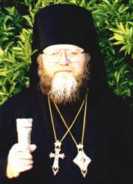
The Australian and New Zealand Diocese, whose present Ruling Bishop is His Grace Archbishop Hilarion, was established in 1946. On the 12 December of that year the Synod of Bishops appointed Archbishop Theodore (Rafal'skii), living in Munich (Germany) at the time, as the Ruling Bishop to the newly established Diocese. Due to difficulties experienced then in obtaining visas the Archbishop arrived to his post only on 5 November, 1948.
There were only two parishes in the whole of Australia at that time: in Brisbane and Sydney. The Brisbane parish was established in 1925 by the Rev. Alexander Shabashev, now deceased. The Sydney parish was established in 1938 by the Rev. (Abbot) Methodius Shlemin, also now deceased.
The Beginnings of the Canberra Parish
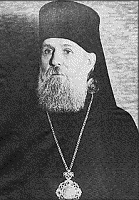
By 1950 there were already several Russian families living in Canberra and Queenbeyan. In answer to their appeal and with the blessing of His Grace Archbishop Theodore, Rev. Theodore Mikhaliuk, the secretary to the Diocesan Administration, organized the first parish general meeting, on 1 April 1952. Rev. Theodore Mikhaliuk informed the congregation about the Normal Church By-Laws sanctioned by the Synod of Bishops of the Russian Orthodox Church Outside Russia. On the basis of these By-Laws the new Orthodox community began its life and development in the name of Saint John the Forerunner.
The First Russian Church in Canberra
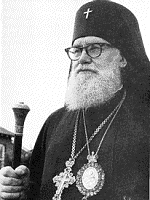
Church services were at first conducted in various venues and churches, then in a big shed at 'Riverside'. In 1960 a temporary building was bought and brought to the block of land in Narrabundah, allotted by the Department of Interior for the erection of at first a temporary and later of a permanent church building. 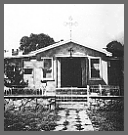 A church, although only temporary, but belonging to the community, was built on this block of land. The building of this temporary church was completed in 1962 and on the 10 June, 1963 the community was renamed to a Parish by a decree of His Grace Archbishop Savva. The parish was registered according to the Normal Parish By-laws on 14 May, 1966.
A church, although only temporary, but belonging to the community, was built on this block of land. The building of this temporary church was completed in 1962 and on the 10 June, 1963 the community was renamed to a Parish by a decree of His Grace Archbishop Savva. The parish was registered according to the Normal Parish By-laws on 14 May, 1966.
The Present Church
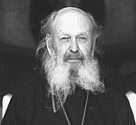
The parish received its first permanent priest only just before Orthodox Christmas in 1965. He was the Rev. Anthony Dudkin who came to Canberra to live and take charge of the parish. 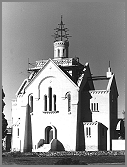 Prior to that various priests travelled to Canberra from Sydney in order to conduct services. Mr. I. V. Goloveshka was elected the church elder, Mr. P. P. Ivanitskas the secretary and
Prior to that various priests travelled to Canberra from Sydney in order to conduct services. Mr. I. V. Goloveshka was elected the church elder, Mr. P. P. Ivanitskas the secretary and 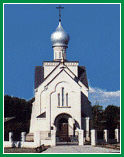 Mr. I. V. Milevich the treasurer of the Parish Council. From 1964 the church services were conducted in the small temporary building until the new permanent church was built and the old building became a temporary church hall.
Mr. I. V. Milevich the treasurer of the Parish Council. From 1964 the church services were conducted in the small temporary building until the new permanent church was built and the old building became a temporary church hall. ![]() The architecture of the permanent church of St. John the Forerunner is in the style of the 14th century churches in the Pskov and Novgorod regions in the north-west of Russia. Building of the church began in 1974 and was officially completed in 1988, the year of the celebrations of the millennium of Russia's conversion to Christianity, when the iconostasis was erected and the church fully consecrated.
The architecture of the permanent church of St. John the Forerunner is in the style of the 14th century churches in the Pskov and Novgorod regions in the north-west of Russia. Building of the church began in 1974 and was officially completed in 1988, the year of the celebrations of the millennium of Russia's conversion to Christianity, when the iconostasis was erected and the church fully consecrated.